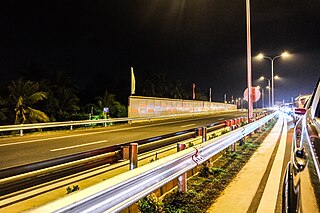
Transport in Sri Lanka is based on its road network, which is centred on the country's commercial capital Colombo. A rail network handles a portion of Sri Lanka's transport needs. There are navigable waterways, harbours and three international airports: in Katunayake, 35 kilometres (22 mi) north of Colombo, in Hambantota, and in Jaffna.

Nugegoda is a large, densely populated suburb of Colombo, Sri Lanka. It is located in the border of Sri Jayawardenapura Municipal Council limits and Dehiwela Mt. Lavinia Municipal Council limits, just outside Colombo city limits. It has a population of roughly over 250,000 people.
Homagama is a town in the Colombo District, Sri Lanka, about 24 kilometres (15 mi) south-east of Colombo. The Homagama Pradeshiya Sabha consists of the Homagama divisional secretariat and 10 GN division of Padukka DS division. The total Land area is about is 137 square kilometres (53 sq mi) of 90 GN division. The Pradeshiya Sabha was established under act No 15 of 1987, and has the highest population of any pradeshiya sabha area in Sri Lanka. It is home to notable places, such as the Technology faculty of University of Colombo, campus of the National School of Business Management, Sri Lanka Institute of Nanotechnology, the Panagoda Cantonment, Upali Newspapers, Mahinda Rajapaksha College Homagama, St. Michael's College, Homagama, Buddhist and Pali University of Sri Lanka, Ceylon Biscuits Limited and the Laxapana Battery Company.
Maharagama is an outer suburb of Colombo, Sri Lanka on the High-Level (A4) Road about 10 km (6.2 mi) from the centre of the commercial capital. It developed rapidly in the 1980s as a dormitory suburb. Governed by the Maharagama Urban Council, the town possesses facilities like supermarkets, department stores, clothing, food and beverages shops to fulfill the needs of citizens.

The Sri Lanka Railway Department is Sri Lanka's railway owner and primary operator. As part of the Sri Lankan government, it is overseen by the Ministry of Transport. Founded in 1858 as the Ceylon Government Railway, it operates the nation's railways and links Colombo with other population centres and tourist destinations.

The Kelani Valley railway line in Sri Lanka, covering the breadth of Colombo District. The line is owned, maintained, and operated by Sri Lanka Railways.
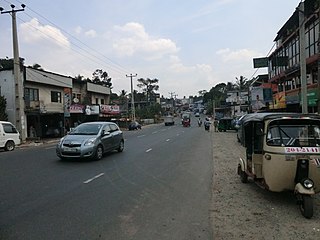
Kottawa is one of the main suburbs in Colombo, Sri Lanka and is administered by the Maharagama Urban Council. It is located 21 km (13 mi) from the centre of Colombo. It is a five-way junction and lies as the epicenter for Maharagama road, Homagama road, Piliyandala road, Malabe road and Borella road.
Maradana is a suburb of Colombo, Sri Lanka. Maradana is the site of Maradana Railway Station, one of the primary railway hubs in the country, serving intercity rail and commuter rail. Maradana also has many railway yards and running sheds. A technical college, many national schools, the Lotus Tower, and business institutions are also located in the area.
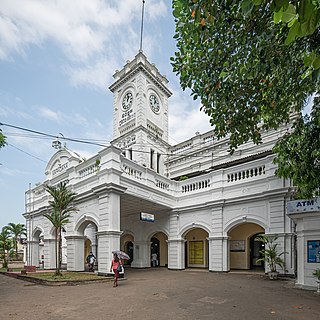
Maradana Railway Station is a major rail hub in Colombo, Sri Lanka. The station is served by Sri Lanka Railways, with many inter-city and commuter trains entering each day. It is the terminus of several intercity trains.
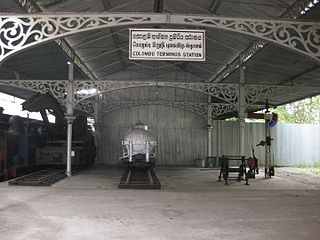
Colombo Terminus Station was the primary railway station in Colombo, Sri Lanka in the nineteenth century. It was retired from service at the beginning of the twentieth century and replaced by Maradana Station. The preserved building is now home to the National Railway Museum.
The Mannar line is a railway line in Sri Lanka. Branching off the northern line at Medawachchiya Junction, the line heads north-west through North Central and Northern provinces before terminating at the town of Talaimannar. The line is 106 kilometres (66 mi) long and has 11 stations. The line opened in 1914.

The Main Line is a major railway line in the rail network of Sri Lanka and considered by many to be one of the most scenic train journeys in all of Asia. The line begins at Colombo Fort and winds through the Sri Lankan hill country to reach Badulla.

The coastal line is a major railway line in Sri Lanka, running between Colombo Fort and Beliatta, via Galle and Matara. Operated by Sri Lanka Railways, the line includes some of the busiest rail services in the country. The line has been extended to Beliatta on 8 April 2019 and is proposed to be extended to Kataragama, via Hambantota. With a designed maximum speed of 100 km/h (62 mph) between Kalutara and Matara, and a maximum speed of 120 km/h (75 mph) between Matara and Beliatta, the line is one of the fastest in Sri Lanka.
Ruhunu Kumari is a daytime passenger train that runs between Colombo and Matara in Sri Lanka.
Gampaha railway station is a railway station in the western city of Gampaha in Sri Lanka. The station is served by Sri Lanka Railways, which is the state-run railway operator.

Hatton Station is a railway station on the Main (Colombo-Badulla) railway line in Sri Lanka. It is situated between Rozella and Kotagala railway stations. It is 173.06 kilometres (107.53 mi) along the railway line from the Colombo Fort Railway Station at an elevation of about 1,262.5 m (4,142 ft) above sea level.
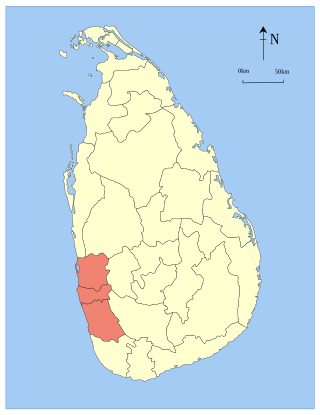
The Western Region Megapolis is an urban planning, zoning, and development area stretching from Negombo in the north to Beruwala in the south. It is designed to create a megapolis in Sri Lanka's Western Province by 2030.
Rajarata Rejini is a daytime passenger train that runs between Anuradhapura and Beliatta via Colombo Fort in Sri Lanka.
Trams existed in Sri Lanka's capital Colombo from 1899 to 1960.
















